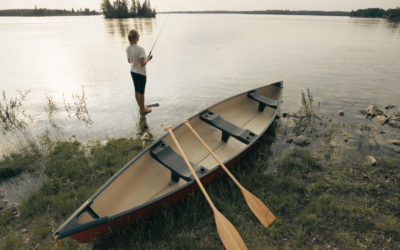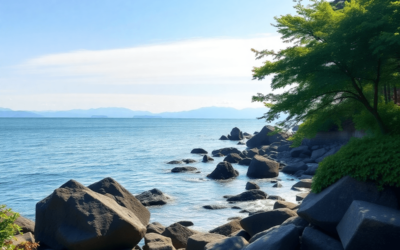Have you ever wondered how Canadian maple syrup is made? It all starts with a tap – quite literally! Maple syrup production in Canada involves tapping the trunks of maple trees and collecting the sap that flows from them. This liquid gold is then boiled down until it reaches a thick consistency, transforming into the Canadian delicacy we know and love.

by wildpixel on Canva
I. Introduction
Maple syrup is a beloved Canadian delicacy enjoyed by many all over the country. It’s made in Canada by tapping maple trees and collecting the sap that flows from them. This liquid gold is then boiled down until it reaches a thick consistency and turns into maple syrup, with it taking about 40 liters of sap to produce one liter of maple syrup! In this blog post, we’ll take a closer look at how maple syrup production works in Canada.
A. What is maple syrup?
It is a sweetener that’s made from the sap of maple trees. It has a distinct flavor and can be used as an alternative to sugar in recipes or enjoyed on its own. It’s available in different grades, ranging from Grade A Light Amber (mildly sweet) to Grade B Dark Robust (strong maple flavor) with each having a sugar content and a different syrup color.
The four maple syrup grades and their characteristics
Grade A: Golden Color & Delicate Taste – This grade has a light color and mild flavor, making it perfect for pancakes, waffles, and other breakfast foods.
Grade A: Amber Color & Rich Flavor – This grade has a darker color and stronger flavor than the golden grade. It’s great for baking, glazes, and marinades.
Grade A: Dark Color & Robust Flavor – This grade has a deep amber color and bold flavor. It’s ideal for cooking savory dishes like roasted meats or vegetables.
Grade A: Very Dark Color & Strong Flavor – This grade has the darkest color and strongest flavor of all. It’s best used as a substitute for molasses or in recipes that call for intense sweetness.

Picture by tacar on Canva
B. How is the syrup made in Canada
In order to make maple syrup, producers must first tap the trunks of maple trees and collect the sap that flows from them. Specialized tools such as taps and buckets are used for this process, with some companies using large systems to collect maple sap. Once the maple sap is collected, it is then boiled down until it reaches a thick consistency and transforms into maple syrup. This process takes around 40 liters of maple sap to produce one liter of maple syrup!
C. Can any maple tree be used?
No, not just any maple tree can be used for making maple syrup. Each region has its own unique varieties of maple trees that are best suited to produce the highest quality syrup. In Canada, for example, the most popular variety is the Sugar Maple Tree, which is known for its intense sweetness and flavor. Other varieties such as Red Maple or Black Maple can also be used in some regions, but they produce a slightly different kind of syrup with a less intense sweetness compared to the Sugar Maple.
II. Tap the Trees
Maple syrup is a beloved natural sweetener that has been enjoyed for centuries. One must tap maple trees to collect their sap to produce this delicious liquid gold. Tapping trees for fresh sap is a process that requires careful planning and execution.
A. Tapping maple trees to collect sap
The first step in tapping trees is to identify which ones are suitable for sap collection. Ideally, you want to select mature trees with a diameter of at least 10 inches at chest height. Once you have identified the trees, it’s time to prepare them for tapping.
To tap a maple tree, you will need a drill bit, spile (a small tube), and a collection container (such as a bucket). Begin by drilling a tap hole about 2 inches deep into the tree’s trunk at waist height using a 5/16-inch drill bit. Insert the spile into the hole and hammer it gently until it fits snugly in place. Hang your collection container on the spile and wait for the sap to flow gallons of sap out.

Picture by Jim_Pintar on Canva
B. Collecting the sap using specialized tools and methods
Once you have tapped your maple trees, it’s time to collect the sap using specialized tools and methods. One popular method is gravity-fed collection, where sap flows from each tree into interconnected plastic tubing that leads to your storage tank or sugar house.
Another method involves vacuum pumping, where suction is used to draw sap from each tree into tubing connected to your storage tank or sugar house. Vacuum pumping can significantly increase sap flow and yield compared to gravity-fed collection.

Picture by jentakespictures on Canva
C. Storage of Collected Sap
After collecting the sap, it needs to be stored properly until it’s ready for processing into syrup. The collected sap should be kept cool (around 38°F) to prevent bacterial growth and spoilage from hot syrup. You can store the sap in food-grade plastic containers or stainless steel tanks that are sealed tightly.

Picture by lauraag on Canva
III. How is maple syrup made
Once the maple sap has been collected and stored, it’s time to boil down and transform it into pure maple syrup.
A. Boiling down the sap until it reaches a thick consistency
The maple sap must be boiled down until it reaches a thick consistency and turns into maple syrup. This process takes several hours and requires careful monitoring to ensure the sap boils at the exact boiling point and does not burn or become too thick. The boiling should take place at about 219°F for about 40 minutes, or until the desired thickness is achieved.
B. Boiling process – Transformation into maple syrup
Once boiling is complete, the maple sap has transformed into pure maple syrup. The concentrated sap should be filtered several times to remove any debris or impurities before the finished syrup could be bottled and enjoyed. The liquid gold can be kept in airtight storage containers for up to a year when kept in a cool and dark place.

Picture by marcduf on Canva
IV. Concluding Thoughts
Maple syrup is a beloved Canadian delicacy that has delighted the taste buds of Canadians for generations. From tapping trees to boiling sap, producing maple syrup requires careful planning and execution.
A. Summary of the production process
To produce maple syrup, the process begins with tapping maple trees and collecting the sap. The sap is then stored until it’s ready for processing into maple syrup, which involves boiling down the sap until it reaches a thick consistency. Once boiling is complete, the maple syrup should be filtered and bottled before being enjoyed.
B. Enjoyment of maple syrup as a Canadian delicacy all over the country!
Maple syrup is a cherished Canadian delicacy that is enjoyed all over the country. Whether it’s drizzled over pancakes, used in baking recipes, or simply eaten as a topping for ice cream and other desserts, maple syrup adds sweetness and flavor to any food. From coast to coast, maple syrup is sure to delight even the most discerning maple syrup fans. There’s something special about maple syrup that makes it a quintessentially Canadian treat, and no one does maple syrup quite like Canada! Enjoying maple syrup is a fun way to celebrate the great nation of Canada, real maple syrup and its unique flavor is sure to add some sweetness to your life.
So go ahead, pour some maple syrup on your favorite food, and enjoy the delicious Canadian delight that is maple syrup!

Picture by vasiliybudarin on Canva




